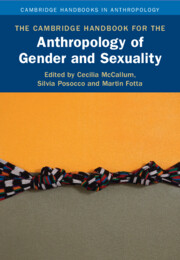Book contents
- The Cambridge Handbook for the Anthropology of Gender and Sexuality
- Cambridge Handbooks in Anthropology
- The Cambridge Handbook for the Anthropology of Gender and Sexuality
- Copyright page
- Contents
- Contributors
- 1 Introduction to The Cambridge Handbook for the Anthropology of Gender and Sexuality
- Part One Openings and Orientations
- Part Two Knowledges and Domains
- Part Three Resistances and Intersections
- Part Four Desires and Relations
- 18 Subjectivities, Knowledge, and Gendered and Sexual Transitions
- 19 Feminist and Queer Theories of the Non/Human and Paradoxical Possibilities of the Slash
- 20 Blood, Gender, and Politics in Indigenous View
- 21 “At Home” in Botox, Feminism, and Ethics
- Part Five Recursivities and Futures
- Name Index
- Subject Index
- References
21 - “At Home” in Botox, Feminism, and Ethics
from Part Four - Desires and Relations
Published online by Cambridge University Press: 29 September 2023
- The Cambridge Handbook for the Anthropology of Gender and Sexuality
- Cambridge Handbooks in Anthropology
- The Cambridge Handbook for the Anthropology of Gender and Sexuality
- Copyright page
- Contents
- Contributors
- 1 Introduction to The Cambridge Handbook for the Anthropology of Gender and Sexuality
- Part One Openings and Orientations
- Part Two Knowledges and Domains
- Part Three Resistances and Intersections
- Part Four Desires and Relations
- 18 Subjectivities, Knowledge, and Gendered and Sexual Transitions
- 19 Feminist and Queer Theories of the Non/Human and Paradoxical Possibilities of the Slash
- 20 Blood, Gender, and Politics in Indigenous View
- 21 “At Home” in Botox, Feminism, and Ethics
- Part Five Recursivities and Futures
- Name Index
- Subject Index
- References
Summary
Following Marilyn Strathern, social anthropologists have interrogated the “awkward relationship” between anthropology and feminism. This chapter revisits the awkwardness of British social anthropology by looking at its problematic relationship not only with feminism but also with anthropology “at home” and with ethical or moral judgments. Its focus is on cosmetic surgery and other quasi-medical cosmetic procedures such as the use of botulinum toxins (e.g., Botox) and dermal fillers. The chapter discusses the tension between anthropological and feminist approaches, revealed when the anthropologist is tasked with taking an ethical stance. It draws on the experience of the anthropologist having, in their early career, to defend anthropology “at home” and, in their late career, chairing a bioethical committee on the ethics of cosmetic procedures, and concludes that there are times when anthropology and feminism best serve each other by maintaining a mutually critical relation: by continuing to trouble each other.
Keywords
- Type
- Chapter
- Information
- Publisher: Cambridge University PressPrint publication year: 2023



